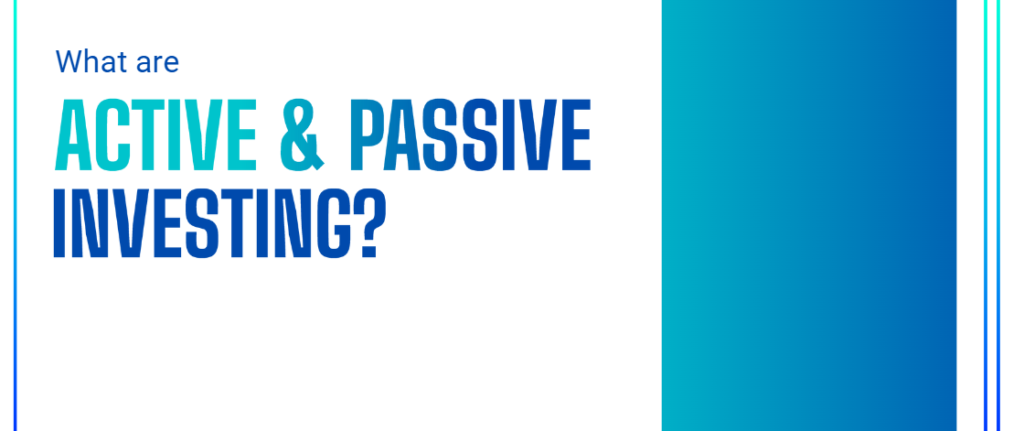
What are Active & Passive Investing?
Active and passive investing are two distinct investment strategies.
The active v/s passive investing debate has been going on for a long in the investment community, with proponents on both sides advocating for their preferred strategy. In this blog post, we’ll look into the intricacies of both of these. Let us start by understanding how are active & passive investing methods relevant in the present investment scenario.

How are Active v/s Passive Investing Methods Relevant in the Current Investment Landscape?
Active and passive investing methods are both relevant in the current investment landscape, each with its advantages and drawbacks.
Active investing can potentially generate higher returns by outperforming the market but requires extensive research and expertise, which can result in higher fees. Passive investing provides a low-cost, diversified investment option that closely tracks the market but does not allow for individual stock selection.
The endless debate of active v/s passive investing has highlighted the need for investors to consider their investment goals and risk tolerance carefully. With the rise of technology, passive investing has become increasingly accessible. However, active investing still has its place for those seeking potentially higher returns and are willing to accept higher risks.
Let us look at the difference between both investment strategies in detail.

Difference between Active & Passive Investing
Active and passive investing are two distinct investment strategies, with significant differences in their approach, performance, fees, and level of involvement.
- Performance- Active investing aims to outperform the market, while passive investing seeks to match the performance of a benchmark index. Active investing may yield higher returns but carries a higher risk, while passive investing typically generates lower returns but involves lower risk.
- Fees- Active investing involves higher fees due to the active management and research required, while passive investing typically has lower fees.
- Level of Involvement- Active investing requires more research, analysis, and decision-making, while passive investing involves minimal decision-making as it tracks a benchmark index.
- Role of Asset Allocation- Active investing often involves strategic asset allocation decisions based on market conditions, while passive investing typically follows a fixed allocation strategy.
- Future of Investment Management- The question of active v/s passive investing has led to the development of hybrid strategies, combining active and passive investing methods for potentially higher returns with lower fees.
While active investing has historically been the dominant approach, the growth of passive investing and technological advancements may lead to changes in the future of investment management.

Pros & Cons of Active Investing
Here are some pros and cons of active investing:
Pros of Active Investing-
- Potential for Higher Returns- Active investing may generate higher returns than passive investing by identifying undervalued securities.
- Flexibility- Active investors have the flexibility to sell underperforming active investments and seek new opportunities.
- Personalization- Active investing allows personalized investment strategies based on individual goals, risk tolerance, and market conditions.
Cons of Active Investing-
- Higher Fees- Active investing typically has higher fees due to the active management and research required.
- Higher Risk- Active investing involves higher risk due to individual stock selection.
- Difficulty in Outperforming the Market- Most active investors consistently fail to outperform the market.

Pros & Cons of Passive Investing
Here are some pros and cons of passive investing:
Pros of Passive Investing-
- Lower Fees- Passive investing typically has lower fees compared to active investing.
- Lower Risk- Passive investing involves lower risk due to its diversified nature and lack of individual stock selection.
- Consistency- Passive investing seeks to match the performance of a benchmark index, providing consistent returns over time.
Cons of Passive Investing-
- Lower Potential Returns- Passive investing may generate lower returns than active investing due to its inability to identify undervalued securities.
- Limited Flexibility- Passive investors have limited flexibility to sell underperforming investments and seek new opportunities.
- Lack of Personalization- Passive investing does not allow for personalized investment strategies.
Now that we have seen the pros & cons of active v/s passive investing let us look at their current trends.
If you need some ideas about what to read next, here they are:
- Managing Conflicts in Family Business: Strategies for Resolving Differences and Maintaining Harmony
- The Role of Family Members as Investors in Family Business: Strategies for Maximizing Returns and Minimizing Risks
- The Changing Landscape of Consumer Debt and the Relationship Between Consumer Debt and Recession Risk

Current Trends in Active v/s Passive Investing
In recent years, the trend toward passive investing has gained momentum, with investors seeking lower fees and consistent returns. However, active investing still has its place, and trends suggest a move toward hybrid investment strategies.
Here are some current trends in active and passive investing:
- Rise of ESG Investing- Environmental, Social, and Governance (ESG) investing has gained popularity, with investors increasingly seeking to match their investments to their values.
- Shift towards Hybrid Strategies- Many investors are adopting a hybrid approach, combining active and passive strategies to maximize returns while minimizing fees.
- Popularity of Index Investing- Index investing remains popular, with investors continuing to buy into popular passive funds.
- Importance of Investment Performance Review- As with any investment strategy, it is crucial to review investment performance regularly to identify underperforming investments and make informed decisions.
Overall, the investment landscape is constantly evolving, and it is essential to stay informed of current trends and adapt investment strategies accordingly. Investors should consider a hybrid approach and review their investment performance regularly to ensure optimal returns.
We have seen the current trends in active v/s passive investing; let us now discuss the future of the same.

Future of Active v/s Passive Investing
The future of investment management is likely to see a continued trend towards passive investing, with its lower fees and more straightforward execution. However, active investing will still have its place, especially in identifying undervalued securities in emerging markets. Here are some likely future trends in active v/s passive investing:
- Greater Use of Technology- The use of technology in investment management is likely to increase with the emergence of robo-advisors and other digital platforms.
- Increased Focus on ESG Investing- Environmental, Social, and Governance (ESG) investing will likely become even more prominent.
- Importance of Asset Allocation- Asset allocation will remain critical to long-term investment growth, with investors allocating assets across a diverse range of investments.
- Growing Interest in Alternative Investments- Alternative investments, such as private equity and real estate, are expected to see increased interest in the future.
While the future of investment management is uncertain, it is essential to stay informed of potential trends and adapt investment strategies accordingly. Investors should continue to allocate assets for long-term growth while keeping a balanced approach between active v/s passive investing.
After all the points that we have looked at, let us now see how investors can decide what is right for them.

How Can Investors Decide Which Investment Style Is Right For Them?
Deciding between active v/s passive investing can be challenging, and investors should consider their goals, risk tolerance, and investment timeframe. Here are some factors to keep in mind when choosing an investment style:
- Investment Goals- Investors should consider their investment goals and whether they seek higher or consistent, lower-risk returns.
- Risk Tolerance- Investors should consider their risk tolerance and decide if they are comfortable with the potential for higher returns with active investing or prefer lower-risk returns with passive investing.
- Investment Timeframe- Investors should consider their investment timeframe and consider if they are investing for the short or long term.
- Role of Asset Allocation- Asset allocation is critical to active and passive investing, and investors should look at diversifying their portfolios across various investments.
Overall, there is no one-size-fits-all approach to investing, and investors should consider their unique circumstances and investment goals when choosing between active and passive investing. Investors should seek professional advice and review their investment strategies regularly to ensure they align with their objectives and risk tolerance.
In the final section, let us also look at an investment alternative that can help you grow your wealth & build your legacy, despite the ongoing economic tensions.
The Bottom Line
Active v/s Passive investing is a topic of much debate in the finance industry. Active investing involves selecting individual stocks and making investment decisions based on market trends and analysis. On the other hand, passive investing involves buying and holding a diversified portfolio of stocks or funds with minimal trading or analysis. While active investing has the potential for higher returns, it also comes with higher costs and risks. In contrast, passive investing is a more cost-effective and low-risk strategy that can provide steady returns over the long term.
Ultimately, the decision between active and passive investing depends on an individual’s investment goals, risk tolerance, and financial situation. Those seeking higher returns and willing to take on more risk may prefer active investing, while those seeking steady, predictable returns may prefer passive investing.
Frequently Asked Questions-
- What is the difference between active and passive investing?
Active investing involves picking individual stocks or assets to outperform the market, while passive investing involves tracking an index or market as a whole with the aim of matching its performance.
- What are the pros and cons of passive investing?
Passive investing’s pros are low costs, easy management, and broad diversification, and the cons are less customization and limited potential returns.
- Can active and passive investing be combined to create a hybrid investment approach?
Yes, investors can combine active and passive investing to create a hybrid investment approach. This approach is known as smart beta or factor-based investing, which seeks to capture market returns while incorporating elements of active management.
Join Our Newsletter
Elevate your financial game & join the ranks of elite investors with Secvolt’s exclusive newsletter.
Join Our Newsletter
Elevate your financial game & join the ranks of elite investors with Secvolt’s exclusive newsletter.
Don’t just dream of wealth; achieve it with Secvolt. Schedule a call today for personalized guidance on your investment strategy and join the ultra-successful.
Ready to unlock your wealth’s truest potential & cherish affluence?
Secvolt, our hedge fund, sets the bar high with a record-breaking performance of 262% returns in 2022. With the brilliance of our highly advanced quant models and the efficiency of our risk mitigation protocols, we are yet to see a loss!
We’re the perfect ally to help you succeed financially and build the lasting legacy you have always aspired for.
Get in touch today. YOUR LEGACY AWAITS YOU…






